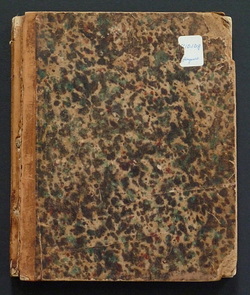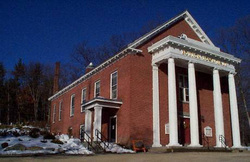
Mary Elizabeth Haynes Journal
Mary Elizabeth was one of four children, and the only girl, born to Francis and Mary Haynes. The Haynes family was prosperous, owning 150 acres of fertile farming land along the interval by the Still River. The family home at 304 Still River Road still stands, a handsome Federal style brick house which was built of bricks from the brickyard on the property that Mary Elizabeth’s grandfather and father owned and operated.
She became a school teacher, never married, and led a quiet life at home. A member of the Still River Baptist Church (now home to the Harvard Historical Society), Mary Elizabeth was a devout Christian, and spent a great amount of her time in religious contemplation, believing that she could best serve God by serving others. This belief was put into practice in her nursing of the ill and sick soldiers during the Civil War.
Mary Elizabeth died from pneumonia at the age of 64 on February 25, 1895. She is buried in the family lot in the West Burial Ground. An American flag honoring her service to our Country stands by her grave.
The Bolton Historical Society has in its possession three journals belonging to Mary Elizabeth Haynes. Written in pencil in standard marble covered composition books, Mary Elizabeth was 24 years old when she penned her first journal. In all, they span twelve years. Mary Elizabeth filled her journals with meditative thoughts and prayers, descriptions of everyday life in Bolton, the joys and labors of school teaching, introspections on marriage, the cloud of war, and the sickness and death of friends and family, especially the death of her brother John. The last journal chronicles her experiences as a volunteer nurse for the Union Army.
These journals offer us a glimpse into the life of an ordinary woman during extraordinary times. In them, Mary Elizabeth describes her world in great detail, preserving for us the history and memories of the people and events in her daily life. The journal chronicling her nine months as a nurse in the Union Army has been transcribed and is available below.
Mary Elizabeth was one of four children, and the only girl, born to Francis and Mary Haynes. The Haynes family was prosperous, owning 150 acres of fertile farming land along the interval by the Still River. The family home at 304 Still River Road still stands, a handsome Federal style brick house which was built of bricks from the brickyard on the property that Mary Elizabeth’s grandfather and father owned and operated.
She became a school teacher, never married, and led a quiet life at home. A member of the Still River Baptist Church (now home to the Harvard Historical Society), Mary Elizabeth was a devout Christian, and spent a great amount of her time in religious contemplation, believing that she could best serve God by serving others. This belief was put into practice in her nursing of the ill and sick soldiers during the Civil War.
Mary Elizabeth died from pneumonia at the age of 64 on February 25, 1895. She is buried in the family lot in the West Burial Ground. An American flag honoring her service to our Country stands by her grave.
The Bolton Historical Society has in its possession three journals belonging to Mary Elizabeth Haynes. Written in pencil in standard marble covered composition books, Mary Elizabeth was 24 years old when she penned her first journal. In all, they span twelve years. Mary Elizabeth filled her journals with meditative thoughts and prayers, descriptions of everyday life in Bolton, the joys and labors of school teaching, introspections on marriage, the cloud of war, and the sickness and death of friends and family, especially the death of her brother John. The last journal chronicles her experiences as a volunteer nurse for the Union Army.
These journals offer us a glimpse into the life of an ordinary woman during extraordinary times. In them, Mary Elizabeth describes her world in great detail, preserving for us the history and memories of the people and events in her daily life. The journal chronicling her nine months as a nurse in the Union Army has been transcribed and is available below.
Your browser does not support viewing this document. Click here to download the document.

Town Book 1738-1778
Among Bolton’s treasures are the records of town affairs kept in the Town Book from the incorporation of the town in 1738 on. They consist of warrants for town meetings and reports on actions taken at those meetings. They were kept by hand in large bound volumes, sometimes faded and hard to decipher, sometimes well-preserved and relatively easy to read. As part of its participation in Freedom’s Way’s Paths of the Patriots, the Bolton Historical Society has been transcribing passages from the earliest volume (1738-1778) relating to the town’s actions in regard to the Revolution. These actions were discussed at many town meetings and ranged from responses to early news coming out of Boston, through the formation of committees to deal with various issues, the appropriation of funds to pay for men and equipment for the war, and the treatment of those thought to be loyal to England. The Declaration of Independence is copied in its entirety into the records. These were, of course, not the only matters to come before the town’s voters during that period. These extracts attempt to bring together from the over 400 pages of this book a picture of how Bolton was participating in the Revolution.
Among Bolton’s treasures are the records of town affairs kept in the Town Book from the incorporation of the town in 1738 on. They consist of warrants for town meetings and reports on actions taken at those meetings. They were kept by hand in large bound volumes, sometimes faded and hard to decipher, sometimes well-preserved and relatively easy to read. As part of its participation in Freedom’s Way’s Paths of the Patriots, the Bolton Historical Society has been transcribing passages from the earliest volume (1738-1778) relating to the town’s actions in regard to the Revolution. These actions were discussed at many town meetings and ranged from responses to early news coming out of Boston, through the formation of committees to deal with various issues, the appropriation of funds to pay for men and equipment for the war, and the treatment of those thought to be loyal to England. The Declaration of Independence is copied in its entirety into the records. These were, of course, not the only matters to come before the town’s voters during that period. These extracts attempt to bring together from the over 400 pages of this book a picture of how Bolton was participating in the Revolution.
Your browser does not support viewing this document. Click here to download the document.